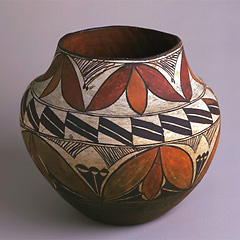Curriculum Materials: Art in America
|
|
Image 11 Keresan Questions: |
Look Questions Teacher Answer Key
1. What is this object? (A jar.) How can you tell? (Opening at the top.) How many colors did the artist use on this jar? (Three.) Name them. (White, black, and red-orange.) Do these colors look natural or artificial?
2. The shapes that artists use in their designs are called GEOMETRIC and ORGANIC. A geometric shape, such as a square, triangle, or circle, has a regular CONTOUR. Geometric shapes often have straight lines and angles. Where do you see geometric shapes in the design of this jar? An organic shape has an irregular contour, formed by curving lines. Where do you see organic shapes on this jar? Which of the shapes look both organic and geometric? Are there more organic shapes or geometric shapes?
3. Is the shape of the jar itself GEOMETRIC or ORGANIC? Southwestern potters sometimes use the names of parts of the human body to refer to sections of their pottery. Which part of this jar is the neck? The feet? The body? The mouth?
4. PATTERNS in a design are created by repeating shapes, lines, and colors. Where on this jar do you see shapes or lines repeated to create patterns? How does the artist use color to help create patterns? How many different patterns do you see? Which pattern on this jar suggests motion? (The pattern created by pairs of black rectangles.)
5. How many horizontal sections do you see on the pot? How does the decoration on each section emphasize the part of the pot it decorates? How do the sections and decorations contribute to the overall balance of the pot?
6. Designs can be
REPRESENTATIONAL,
NONREPRESENTATIONAL,
or a combination of both. Representational designs are those
with elements we can recognize from the world around us,
even if ABSTRACTED.
Nonrepresentational designs have no obvious reference to the
world around us. Which elements in this design do you
consider representational? Which do you consider
nonrepresentational? Is the design primarily
representational or nonrepresentational?
|
|
